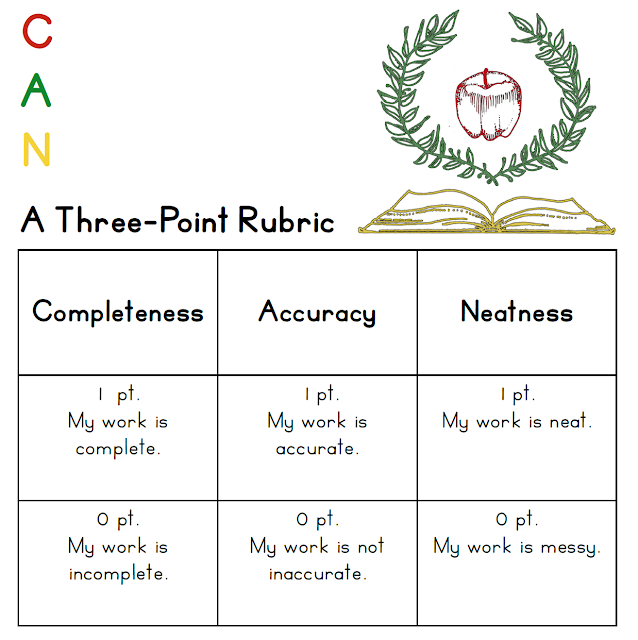Dear 2B Families,
Welcome to Week 6!
Island Projects came in today. I loved seeing them! Please look for your child's score this Friday.
Speaking of scores and grades, as you receive work back, you may see the words CAN written at the top of papers. This is my scoring guide for homework and some classwork. I discussed this with you at Curriculum Night, but in case you were unable to make it or need some clarification of the matter, please see the rubrics below. C stands for complete, A stands for Accurate, and N stands for Neat. When I or Ms. Cloward score assignments, we want to be as objective as possible. Homework assignments are graded on the 3-point rubric.
Here is what second graders are up to this week:
MATHEMATICS
We are calculating our way through Unit 2 starting this week! Encourage your child to take their time and line up their digits neatly on homework this week. Also encourage them to draw place value charts for their equations!
Welcome to Week 6!
Island Projects came in today. I loved seeing them! Please look for your child's score this Friday.
Speaking of scores and grades, as you receive work back, you may see the words CAN written at the top of papers. This is my scoring guide for homework and some classwork. I discussed this with you at Curriculum Night, but in case you were unable to make it or need some clarification of the matter, please see the rubrics below. C stands for complete, A stands for Accurate, and N stands for Neat. When I or Ms. Cloward score assignments, we want to be as objective as possible. Homework assignments are graded on the 3-point rubric.
Here is what second graders are up to this week:
LITERATURE
We are reading Chapters 15-19 of Charlotte’s Web this week. We will be discussing humility as a
theme of the story and as a character trait, but also why humility is a virtue
and how it manifests itself in thoughts, actions, and behavior. Here are the
vocabulary words we will look at: yarn,
pummeled, pickpockets, midway, listless, keen, humble, schemer, magnum opus,
languishing, bystander.
SPELLING
Your second grader will finish Section K of the Spalding
Spelling list with 29 words this week. On Monday, we will spell light, coming, come, night, pass, shut,
easy, ease, bone, cloud. On Tuesday, we will spell draw, drink, garden, goose, hopping, hop, knife, mouth, oak, peach. On
Wednesday, we spell pole, queen, rope, season, sign, space,
wagon, wheat, window. Please
continue to dictate each word one and at time to your child as he or she
practices them each evening. Ask your child to tell you when one can use the
phonogram “kn” and when one can use “gn” in a word.
POETRY
It is time for second graders to memorize stanza 3 of
“Something Told the Wild Geese.” We begin recitations at the end of next week.
WRITING
We copy and write lines from verse this week. Students learn
how capitalization is used in song and poetry and then practice what they learn
as they transcribe lines from a sweet song Charlotte sings to Wilbur. Your
child will continue to practice writing short summaries of passages from Charlotte’s Web.
GRAMMAR
We review capitalization and punctuation rules. Students
have learned 6 capitalization rules and 8 punctuation rules. Show your child a
sentence from a book and ask him or her to explain why certain words are
capitalized. We add The Adverb Jingle to our repertoire!
MATHEMATICS
We are calculating our way through Unit 2 starting this week! Encourage your child to take their time and line up their digits neatly on homework this week. Also encourage them to draw place value charts for their equations!
HISTORY
This week we will begin our studies of ancient cultures with
Ancient India. Your student will be able to locate India on a map and explain why
the Indus River was important for the civilization to form. We will also learn
about Hinduism as a world religion by discussing the three most important Hindu
gods and the caste system.
SCIENCE
We will be talking about the chicken life cycle this week.
Then we will HOP into a discussion on frogs! We will learn about how the frog
experiences metamorphosis through these stages: egg, tadpole, froglet, and
adult frog. Did you know that there are thousands of different kinds of frogs
in the world and they don't all look alike? See if your 2nd grader can answer
these to questions: Do you know what a group of frogs is called? Frogs live on
every continent in the world except _____.
Have a great week!
Mrs. Dill


Comments
Post a Comment